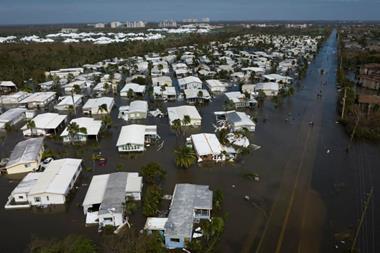Building resilience into our global society has to begin now, with significant benefits for risk managers
As summer temperatures soar to record levels across the globe, the writing is on the wall about the dangers of climate change and the impact of global warming on everyday life.
Time is running out for delivering on the strategic goals as agreed by governments at successive climate conferences for mitigating the effects of climate change and developing a more sustainable global economy.
But despite much discussion and formulation of strategy, there has been comparatively little action on achieving the goals being set.
Building resilience into our global society has to begin now, and a considered approach to planning and constructing the built environment that takes account of the impact of changing global weather patterns will be a key part of this process.
Such actions also present a significant benefit to risk managers, by reducing the impact of large insured losses that could drive up premiums, and through helping insurance buyers manage their risks better.
Resilience needs to be systemic in nature. Instead of focusing on a single client or location, we need to think about deploying resilience across the whole built environment.
Too late for denial
It might be too late to deny the consequences of climate change, but it’s not too late to mitigate the effects.
For those doomsayers convinced that climate change is immutable and that flooded homes, shrinking water sources and failing crops are inevitable, fostering awareness of the problem is the first step to take in addressing it.
An important next step for business is to move the topic up the agenda in the boardroom, taking it from a strategic public relations exercise to an actual risk exposure assessment.
Companies need to see the bigger picture and consider the impact of climate change on health and safety in the wider community, and on the resilience of essential infrastructure such as water, electricity, communications, and public transport networks.
As recent broker reports have noted, events over the last decade have highlighted the vulnerability of the global economy to climate change, especially when supply chains for key commodities are disrupted by natural perils driven by global warming.
With catastrophic flooding in parts of western Europe last year and an unprecedented heatwave this summer, contributing to major wildfires in France and falling river levels that threatened commercial traffic on the Rhine, a major European trade artery, it is clear that climate change is having a measurable impact on everyday life and business.
Mitigation, sustainability and resilience
When considering climate change coping strategies, it’s important to think about resilience as an integral part of everything an organisation does.
The World Economic Forum (WEF) stresses the importance of ‘mitigation’, by which it means a sustainable approach that goes beyond public commitments to net zero carbon targets or limiting temperature increases, to direct action on increasing the resilience of human activities and habitats.
Affirmative action on mitigation could also help to avert the huge financial losses from natural catastrophes that not only hit businesses’ balance sheets directly, but also impact the affordability and availability of insurance capacity.
As WEF indicates, in some regions, climate risks are becoming are rendering around 4% of domestic properties in the country uninsurable.
In fact, going forward, we may anticipate that uninsurability of natural perils in certain geographic areas is set to increase to even higher levels.
A sustainable and concerted approach by the insurance industry, risk managers and other stakeholders including governments and developers would not only reduce the impact of climate change, but also ensure that more capacity is available to insurance buyers who have hitherto struggled to secure cover.
Building systemic resilience
Trying to embed construction codes in planning laws that will address key climate resilience issues has historically proved to be challenging.
While national governments and organisations like the WEF periodically produce white papers addressing this issue, without the political will to legislate for climate-specific building codes, resilience initiatives fail to gain any traction.
Insurers have long been involved in helping their risk manager clients with building resilience on a localised business location or process basis but have little say in the enforcement and application of construction codes.
Insurers’ risk engineers and consultants will of course advise their clients on specific hardening measures to guard against all types of physical and business interruption loss scenarios, but this is unlikely to be in the context of a wider resilience strategy, involving multiple industries as well as regional/national infrastructure.
Further, the cost of climate change for uninsured or uninsurable risk exposures is not typically front of mind for insurance companies when consulting on a risk.
This approach clearly needs to change.
If the insurance industry can engage with the risk management community to build systemic resilience into infrastructure and global supply chains, then not only communities but entire business ecosystems will benefit as a result.
Concrete measures needn’t involve concrete
Some of that project-specific advice from insurers to risk managers could include the strengthening and upgrading of flood barriers, elevation of properties above flood risk levels, increasing sewage capacity and retention, building for greater temperature variations (both heat and cold), and building for storm resilience (in anticipation of a higher frequency and severity of storms and freak weather patterns).
Such moves can benefit society more widely if they become embedded in companies’ strategic resource and sustainability management systems, ensuring that over the longer term, environmental and climate risks are managed and resilience is built.
But systemic resilience is not simply about improving the location, construction and maintenance of buildings and infrastructure.
It can also involve measures such as improving drylands to ensure crops can grow, protecting important natural resources and buffers such as mangrove swamps and rainforests, and ensuring that water supplies are resilient.
Many larger corporations are already focused on taking ESG strategies from the boardroom and into the field.
Deploying resilience action plans in concert with insurance partners and other stakeholders could ultimately improve the business environment in which they operate, contributing to a global resilience strategy to stem the rising tide of climate change threats.
J Anton Koch is Vice President, Risk Management Group, Global Markets at Allied World Assurance Company in Singapore




















No comments yet